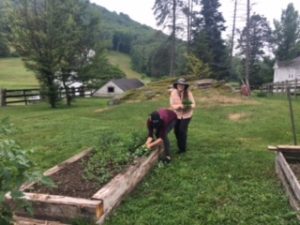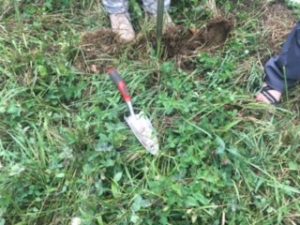“Get Dirty”: SEE-U Agro/Food Students Explore Sustainable Soil Management
Last week, SEE-U Agro/Food students had their first site visit at a small sustainable farm in Wingdale, NY in the Harlem Valley. They gained an understanding of the ways modern farming has contributed to soil degradation and the fundamentals of soil management.


The following blog post was written by SEE-U Agro/Food student Rachel Churchill:
Get Dirty
I had the opportunity this past week to get a crash course in the life of sustainable farming. Josh, the proprietor of this farm, though a farmer, considers himself a ‘rancher’ due to the thousands of organisms that live in his soil that are vital to the health of the soil and, therefore, vital to the sustainability of his farm. These organisms have to be maintained in a delicate balance in order to provide the necessary function in the process of plant growth. Without this delicate balance, soil suffers, plants don’t grow, and cattle aren’t able to graze – life ceases to be sustained.
Preserving this balance requires an effective means of preventing soil degradation. Soil management is the process that refers to the methods devised to prevent soil from degradation or restore it if it does become degraded. Some of these methods include: cover crops, to protect the soil from wind and water erosion in the off-season; crop rotation – to include fallow periods – in order to prevent the soil from becoming accustomed to only one type of nutrient and produces greater fertility and crop yield; and nutrient management that also helps the production of organic, carbon-based compounds in the soil that, in turn, improves soil structure. Soil structure promotes root growth and the emergence of seedlings, and this helps prevent erosion and also contributes to a higher crop yield. Each element of this process helps facilitate the others, working in harmony to maintain the balance.
The modernization of farming has made it so that the primary motive of farming is profit. The demands placed on the farming industry – and the soil as a result – have required modern farmers to resort to methods that are extremely harmful to soil. Due to the demand and high volume crop production, farmers are either unable or unwilling to allow their fields to lay fallow to replenish nutrients. Because of this, engineered means of meeting the demand of the farming industry have been implemented as industry standard and have changed the face of farming. Resultantly, soil is unhealthy with nutrient depletions and the build up of harsh chemical residuals that are prevalent in the crops we consume.
Poor soil management can be traced back to the traditional practices of European settlers for soil preparation. The tilling of land with ploughs led to the disruption of soil aggregates and the reduction of pore spaces that led to the reduction of aeration and water infiltration. Early farming conventions also included planting monocultures that led to low crop productivity, acceleration in erosion, and the aggravation of rapidly depleting farmland. Poor traditional practices combined with modern industrial demands have fostered the use of damaging additives to both crop and soil (Soil Management).
I was told over this past week that “nature is the best farmer.” However, if we left our food production to nature, we would all starve. Human intervention is necessary to the production of food quantities that will sustain a population, which is why proper soil management is so important to the sustainability of that soil. In order to sustain food and livelihood security, the restoration of soil for the purposes of enhancing crop and livestock production through the application of appropriate soil management methods is essential. When the symptoms of soil degradation present themselves, efforts to restore the soil’s nutrients must be combined with proper irrigation and aeration practices, crop rotation, cover crops in the off-season, minimal disturbance of the soil aggregates – all in order to maintain healthy soil for crop yield (Soil Conservation).




Submit Comment